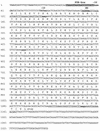Helicobacter pylori ribBA-mediated riboflavin production is involved in iron acquisition
- PMID: 9515916
- PMCID: PMC107047
- DOI: 10.1128/JB.180.6.1473-1479.1998
Helicobacter pylori ribBA-mediated riboflavin production is involved in iron acquisition
Abstract
In this study, we cloned and sequenced a DNA fragment from an ordered cosmid library of Helicobacter pylori NCTC 11638 which confers to a siderophore synthesis mutant of Escherichia coli (EB53 aroB hemA) the ability to grow on iron-restrictive media and to reduce ferric iron. Sequence analysis of the DNA fragment revealed the presence of an open reading frame with high homology to the ribA gene of Bacillus subtilis. This gene encodes a bifunctional enzyme with the activities of both 3,4-dihydroxy-2-butanone 4-phosphate (DHBP) synthase and GTP cyclohydrolase II, which catalyze two essential steps in riboflavin biosynthesis. Expression of the gene (designated ribBA) resulted in the formation of one translational product, which was able to complement both the ribA and the ribB mutation in E. coli. Expression of ribBA was iron regulated, as was suggested by the presence of a putative FUR box in its promotor region and as shown by RNA dot blot analysis. Furthermore, we showed that production of riboflavin in H. pylori cells is iron regulated. E. coli EB53 containing the plasmid with H. pylori ribBA excreted riboflavin in the culture medium, and this riboflavin excretion also appeared to be iron regulated. We postulate that the iron-regulated production of riboflavin and ferric-iron-reduction activity by E. coli EB53 transformed with the H. pylori ribBA gene is responsible for the survival of EB53 on iron-restrictive medium. Because disruption of ribBA in H. pylori eliminates its ferric-iron-reduction activity, we conclude that ribBA has an important role in ferric-iron reduction and iron acquisition by H. pylori.
Figures






Similar articles
-
Structural and functional analysis of the riboflavin synthesis genes encoding GTP cyclohydrolase II (ribA), DHBP synthase (ribBA), riboflavin synthase (ribC), and riboflavin deaminase/reductase (ribD) from Helicobacter pylori strain P1.FEMS Microbiol Lett. 2000 Oct 15;191(2):191-7. doi: 10.1111/j.1574-6968.2000.tb09339.x. FEMS Microbiol Lett. 2000. PMID: 11024263
-
Hemolytic properties and riboflavin synthesis of Helicobacter pylori: cloning and functional characterization of the ribA gene encoding GTP-cyclohydrolase II that confers hemolytic activity to Escherichia coli.Med Microbiol Immunol. 1998 Mar;186(4):177-87. doi: 10.1007/s004300050062. Med Microbiol Immunol. 1998. PMID: 9574900
-
Identification of iron-regulated genes of Helicobacter pylori by a modified fur titration assay (FURTA-Hp).FEMS Microbiol Lett. 2000 Mar 15;184(2):225-9. doi: 10.1111/j.1574-6968.2000.tb09018.x. FEMS Microbiol Lett. 2000. PMID: 10713425
-
Cloning and functional characterization of the genes encoding 3-dehydroquinate synthase (aroB) and tRNA-guanine transglycosylase (tgt) from Helicobacter pylori.Med Microbiol Immunol. 1997 Oct;186(2-3):125-34. doi: 10.1007/s004300050054. Med Microbiol Immunol. 1997. PMID: 9403840
-
Riboswitch-mediated regulation of riboflavin biosynthesis genes in prokaryotes.3 Biotech. 2022 Oct;12(10):278. doi: 10.1007/s13205-022-03348-3. Epub 2022 Sep 14. 3 Biotech. 2022. PMID: 36275359 Free PMC article. Review.
Cited by
-
Unique host iron utilization mechanisms of Helicobacter pylori revealed with iron-deficient chemically defined media.Infect Immun. 2010 May;78(5):1841-9. doi: 10.1128/IAI.01258-09. Epub 2010 Feb 22. Infect Immun. 2010. PMID: 20176792 Free PMC article.
-
Extracellular iron reduction is mediated in part by neutral red and hydrogenase in Escherichia coli.Appl Environ Microbiol. 2004 Jun;70(6):3467-74. doi: 10.1128/AEM.70.6.3467-3474.2004. Appl Environ Microbiol. 2004. PMID: 15184145 Free PMC article.
-
Global transcriptional response of Caulobacter crescentus to iron availability.BMC Genomics. 2013 Aug 13;14:549. doi: 10.1186/1471-2164-14-549. BMC Genomics. 2013. PMID: 23941329 Free PMC article.
-
Iron Acquisition by Bacterial Pathogens: Beyond Tris-Catecholate Complexes.Chembiochem. 2020 Jul 16;21(14):1955-1967. doi: 10.1002/cbic.201900778. Epub 2020 Apr 14. Chembiochem. 2020. PMID: 32180318 Free PMC article. Review.
-
Multi-metal Restriction by Calprotectin Impacts De Novo Flavin Biosynthesis in Acinetobacter baumannii.Cell Chem Biol. 2019 May 16;26(5):745-755.e7. doi: 10.1016/j.chembiol.2019.02.011. Epub 2019 Mar 21. Cell Chem Biol. 2019. PMID: 30905682 Free PMC article.
References
-
- Bacher A. Biosynthesis of flavins. In: Muller F, editor. Chemistry and biochemistry of flavoenzymes. Vol. 1. Boca Raton, Fla: Chemical Rubber Co.; 1991. pp. 215–259.
-
- Bandrin S V, Rabinovich P M, Stepanov A I. Three linkage groups of genes involved in riboflavin biosynthesis in Escherichia coli. Sov Genet. 1983;19:1103–1109. - PubMed
-
- Barchini E, Cowart R E. Extracellular iron reductase activity produced by Listeria monocytogenes. Arch Microbiol. 1996;166:51–57. - PubMed
-
- Bereswill S, Fassbinder F, Covacci A, Völzing C, Ries H, Bacher A, Kist M. Characterization of the Helicobacter pylori ribA gene that confers haemolytic activity to Escherichia coli. Ir J Med Sci. 1997;166:30.
-
- Bienfait H F, Bino R J, van der Bliek A M, Duivenvoorden J F, Fontaine J M. Characterization of ferric reducing activity in roots of Fe-deficient Phaseolus vulgaris. Physiol Plant. 1983;59:196–202.
MeSH terms
Substances
LinkOut - more resources
Full Text Sources
Other Literature Sources
Medical
Molecular Biology Databases

